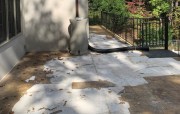Contract language
Don’t assume your commercial general liability insurance policy will make the project owner whole should your workmanship cause the failure. Coverage kicks in only when your work or products damages the work of other contractors on the job.
“Most small contractors don’t understand that until they’re involved in a suit,” says Todd Scharich, a former mason and decorative concrete contractor who oversees the American Society of Concrete Contractors (ASCC) members-only Decorative Concrete Hotline (888-483-5288).
You could try adding construction statute-of-limitation language to the contract, but it won’t necessarily insulate your firm.
Three great resources
Not matter who’s at fault, here’s some resources on how to protect yourself in case of coating failures. Read More
“There are two- , six- , and 10-year rules, but every one has been challenged and specific cases have had the time frames waived and extended,” Scharich says. “It would also be a monstrous red flag to the general contractor and its counsel.”
For more about insurance, contact Wayne Kirkland (wayne.kirkland@cna.com) at CNA, the primary supplier to ASCC members.
Document, document, document
The best way to help failure investigators sort fact from conjecture, innuendo, and opinion is to document your work. Whenever possible, supplement written notes and forms with photographs and videos. Don’t forget to date and, if possible, time-stamp everything.
At the very least, document the results of pre-application moisture testing of any areas of concern. Also track when you shared these concerns with the general contractor.
It’s not required, but monitoring and noting such atmospheric conditions as temperature, humidity, and HVAC system status is recommended — use a data logger.
“I’d be shocked if more than 50% of flooring contractors log the conditions,” says Scharich.



